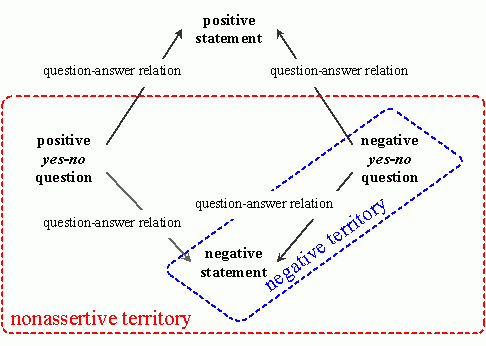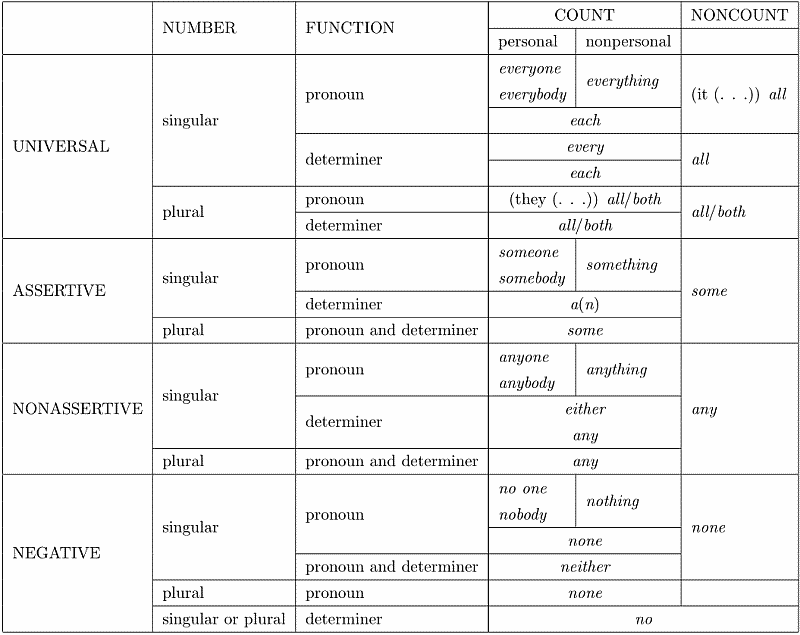2024-10-26 Sat
■ #5661. 否定とは何か? [negation][polarity][negative][terminology][syntax][double_negative][logic][assertion][semantics]
昨日の記事「#5670. なぜ英語には単数形と複数形の区別があるの? --- Mond での質問と回答より」 ([2024-10-24-1]) で,否定 (negation) の話題を最後に出しました.言語において否定とは何か.これはきわめて大きな問題です.論理学や哲学からも迫ることができますが,ここでは言語学の観点に絞ります.
言語学の用語辞典に頼ることから始めましょう.まず Crystal (323--24) より引用します.
negation (n.) A process or construction in GRAMMATICAL and SEMANTIC analysis which typically expresses the contradiction of some or all of a sentence's meaning. In English grammar, it is expressed by the presence of the negative particle (neg, NEG) not or n't (the CONTRACTED negative); in LEXIS, there are several possible means, e.g. PREFIXES such as un-, non-, or words such as deny. Some LANGUAGES use more than one PARTICLE in a single CLAUSE to express negation (as in French ne . . . pas). The use of more than one negative form in the same clause (as in double negatives) is a characteristic of some English DIALECTS, e.g. I'm not unhappy (which is a STYLISTICALLY MARKED mode of assertion) and I've not done nothing (which is not acceptable in STANDARD English). . . .
A topic of particular interest has been the range of sentence STRUCTURE affected by the position of a negative particle, e.g. I think John isn't coming v. I don't think John is coming: such variations in the SCOPE of negation affect the logical structure as well as the semantic analysis of the sentence. The opposite 'pole' to negative is POSITIVE (or AFFIRMATIVE), and the system of contrasts made by a language in this area is often referred to as POLARITY. Negative polarity items are those words or phrases which can appear only in a negative environment in a sentence, e.g. any in I haven't got any books. (cf. *I've got any books).
次に Bussmann (323) を引用します.論理学における否定に対して言語学の否定を,次のように解説しています.
In contrast with logical negation, natural language negation functions not only as sentence negation, but also primarily as clausal or constituent negation: she did not pay (= negation of predication), No one paid anything (= negation of the subject NP), he paid nothing (= negation of the object NP). Here the scope (= semantic coverage) of negation is frequently polysemic or dependent on the placement of negation, on the sentence stress . . . as well as on the linguistic and/or extralinguistic context. Natural language negation may be realized in various ways: (a) lexically with adverbs and adverbial expressions (not, never, by no means), indefinite pronouns (nobody, nothing, none), coordinating conjunctions (neither . . . nor), sentence equivalents (no), or prepositions (without, besides); (b) morphologically with prefixes (in + exact, un + interested) or suffix (help + less); (c) intonationally with contrastive accent (in Jacob is not flying to New York tomorrow the negation can refer to Jacob, flying, New York, or tomorrow depending which elements are stressed); (d) idiomatically by expressions like For all I care, . . . . Formally, three types of negation are differentiated: (a) internal (= strong) negation, the basic type of natural language negation (e.g. The King of France is not bald); (b) external (= weak) negation, which corresponds to logical negation (e.g. It's not the case/it's not true that p); (c) contrastive (= local) negation, which can also be considered a pragmatic variant of strong negation to the degree that stress and the corresponding modifying clause are relevant to the scope of the negation (e.g. The King of France is not bald, but rather wears glasses. The linguistic description of negation has proven to be a difficult problem in all grammatical models owing to the complex interrelationship of syntactic, prosodic, semantic, and pragmatic aspects.
この2つの解説に基づいて,言語学における否定に関する論点・観点を箇条書き整理すると次のようになるでしょうか.
1. 否定の種類と範囲
・ 文否定 (sentence negation)
・ 節否定 (clausal negation)
・ 構成要素否定 (constituent negation)
2. 否定の実現様式
・ 語彙的 (lexically): 副詞,不定代名詞,接続詞,前置詞など
・ 形態的 (morphologically): 接頭辞,接尾辞
・ 音声的 (intonationally): 対照アクセント
・ 慣用的 (idiomatically): 特定の表現
3. 否定の形式的分類
・ 内的(強い)否定 (internal/strong negation)
・ 外的(弱い)否定 (external/weak negation)
・ 対照的(局所的)否定 (contrastive/local negation)
4. 否定の作用域 (scope)
・ 否定辞の位置による影響
・ 文強勢による影響
・ 言語的・非言語的文脈による影響
5. 2重否定 (double negative)
・ 方言や非標準英語での使用
・ 文体的に有標な肯定表現としての使用
6. 極性 (polarity)
・ 肯定 (positive/affirmative) vs. 否定 (negative)
・ 否定極性項目
7. 否定に関する統語的,韻律的,意味的,語用論的側面の複雑な相互関係
8. 自然言語の否定と論理学的否定の違い
この一覧は,否定の複雑さと多面性を示しています.案の定,抜き差しならない問題です.
・ Crystal, David, ed. A Dictionary of Linguistics and Phonetics. 6th ed. Malden, MA: Blackwell, 2008. 295--96.
・ Bussmann, Hadumod. Routledge Dictionary of Language and Linguistics. Trans. and ed. Gregory Trauth and Kerstin Kazzizi. London: Routledge, 1996.
2023-06-27 Tue
■ #5174. 不定代名詞・決定詞 [pronoun][personal_pronoun][generic][indefinite_pronoun][determiner][assertion][semantics][logic]
現代英語には不定代名詞 (indefinite_pronoun) や不定決定詞 (indefinite determiner) という語類の体系がある.不定 (indefinite) の反対は定 (definite) である.例えば人称代名詞,再帰代名詞,所有代名詞,指示代名詞,そしてときに疑問代名詞にも定的な要素が確認されるが,不定代名詞にはそれがみられない.ただし,不定代名詞・決定詞は,むしろ論理的観点から,量的である (quantitative) ととらえてもよいかもしれない.全称的 (universal) か部分的 (partitive) かという観点である.
Quirk et al. (§6.45) に主要な不定代名詞・決定詞の一覧表がある.こちらを掲載しよう.体系的ではあるが,なかなか複雑な語類であることがわかるだろう.
・ Quirk, Randolph, Sidney Greenbaum, Geoffrey Leech, and Jan Svartvik. A Comprehensive Grammar of the English Language. London: Longman, 1985.
2022-01-21 Fri
■ #4652. any が「どんな?でも」を表わせるように either は「いずれの?でも」を表わせる [pronoun][adjective][assertion][dual][logic][semantics][contronym]
Any child can do that. という文は「どんな子供でもそれができる」の意を表わします.力点の置き方は異なりますが,基本的な意味としては All children can do that. とおよそ同等です.
平行的な例を挙げます.Either way will do. という文は「いずれのやり方でもうまく行きます」の意を表わします.力点の置き方は異なりますが,基本的な意味としては Both ways will do . とおよそ同等です.
特に2つめの either と both を用いた例文ペアが同義で用いられ得るというのは,なかなかの驚きではないでしょうか.というのは,私たちは either (A or B) と both (A and B) は対義表現であると信じ込まされてきたからです.しかし,この2つは文脈によってはむしろ類義表現というべきものになり得るのです.
either は,一般には2つあるものの「いずれか」「片一方」を意味すると理解されていますが,実は「いずれの○○でも(よい)」という関連する語義からは「○○の両方であっても(よい)」の解釈が生じ得ます.論理学の喩えでいえば,or には「排他的選言」 (exclusive disjunction) と「非排他的選言」 (inclusive disjunction) の両義があることに相当するでしょうか.
ということで,多少のニュアンスの違いはありながらも,either は both でパラフレーズできてしまうケースがあるのです.例えば,次の例を参照.
・ Unfortunately I was sitting at the table with smokers on either side of me.
・ Unfortunately I was sitting at the table with smokers on both sides of me.
この either vs both の意味論的緊張関係は,any vs all の緊張関係とパラレルです.前者は2つのものについて,後者は3つ以上のものについて,という違いがあるだけです (cf. Quirk et al. §6.61).言い換えれば,前者は意味論的に両数あるいは双数 (dual) の性質をもっているということです.
印欧語の数カテゴリーの重要なメンバーだった両数は,英語にも化石的な形ではありますが,所々に痕跡を残しています.both, either, neither, other, whether など -er をもつものが多いですね (cf. 「#3005. or の語源」 ([2017-07-19-1])) .
・ Quirk, Randolph, Sidney Greenbaum, Geoffrey Leech, and Jan Svartvik. A Comprehensive Grammar of the English Language. London: Longman, 1985.
2018-12-14 Fri
■ #3518. 条件節と疑問文の近さ [conditional][word_order][syntax][assertion][construction_grammar]
昨日の記事「#3517. if を使わずに V + S とする条件節」 ([2018-12-13-1]) で,V + S の条件節(動詞は典型的に接続法)の発達について取りあげた.現代英語で最も普通に V + S の語順をとるのは疑問文である.とすると,条件節と疑問文の間に何らかの接点があるのかないのかという疑問が湧くだろう.これについて考えてみよう.
条件節と疑問文は,確かに近い関係にある.まず,間接疑問を導く接続詞に if が用いられることを思い起こしたい.He asked if I liked Chinese food. (彼は私に中華料理が好きかと尋ねた」や Let me know if she is coming 「彼女が来るか知らせてください」など.後者では if が「?かどうか」の名詞節を導くのか,「?ならば」の副詞節を導くのかは文脈に応じて異なり得るという点で両義的だが,まさにこの両義性こそが「条件」と「疑問」の接点となるのである.日本語訳に現われる係助詞「か」も,典型的に疑問を表わすことに注意.
意味論的あるいは論理的にいえば,条件節も疑問文も "nonassertive" であるという点で共通している.つまり,ある命題について断定していないということである.命題とは別の可能性も含意するという点で,"alternative possible worlds" を前提としていると言い換えてもよいだろう.両者が異なるのは,条件節はそれだけでは何の発話行為にもならないが,疑問文ではそれだけで「疑問・質問」という発話行為となることだ.ついでにいえば,「願望」も命題の表わす事態がまだ起こっていないことを前提とするので nonassertion のもう1つの典型である.may 祈願文などは単独で「願望」の発話行為となる点で疑問文と共通する.
このように考えてくると,なぜ条件節が疑問文と同様に V + S の語順をとるのか,おぼろげながら両者の接点が見えてくるのではないか.昨日の記事でも示唆した通り,「疑問」「接続法」「願望」「条件」というキーワードは互いにリンクしているようだ.
(non)assertion については,「#679. assertion and nonassertion (1)」 ([2011-03-07-1]),「#680. assertion and nonassertion (2)」 ([2011-03-08-1]),「#950. Be it never so humble, there's no place like home. (3)」 ([2011-12-03-1]) の記事を参照されたい.
・ Leuschner, Torsten and Daan Van den Nest. "Asynchronous Grammaticalization: V1-Conditionals in Present-Day English and German." Languages in Contrast 15 (2015): 34--63.
2011-12-03 Sat
■ #950. Be it never so humble, there's no place like home. (3) [negative][syntax][subjunctive][assertion][expletive]
[2011-12-01-1], [2011-12-02-1]の記事で議論してきた,譲歩表現 never so (= ever so) の問題を続ける.
never so と ever so がほぼ同義であるということは一見すると理解しがたいが,nonassertion の統語意味的環境では,対立が中和することがある( nonassertion については[2011-03-07-1]と[2011-03-08-1]の記事を参照).例えば,Quirk et al. (Section 8.112 [p. 601]) は次のように言及し,例文を挙げている.
In nonassertive clauses ever (with some retention of temporal meaning) can replace never as minimizer; this is common, for instance, in rhetorical questions:
Will they (n)ever stop talking? Won't they ever learn? (*Won't they never learn?)
I wondered if the train would (n)ever arrive.
最後の例文にあるように,動詞 wonder に続く if 節内では,肯定と否定の対立が中和されることが多い.節内が統語的に肯定であれば文全体に否定の含意が生じ,統語的に否定であれば肯定の含意が生じるともされるが,意味上の混同は免れない.wonder は「よくわからない」を含意するのであるから,結局のところ,続く if 節,whether 節は nonassertion の性質を帯びるということだろう.
・ He was beginning to wonder whether Gertrud was (not) there at all.
・ He's starting to wonder whether he did (not) the right thing in accepting this job.
・ I wonder if he is (not) over fifty.
・ I wonder if I'll (not) recognize him after all these years.
・ I wonder whether it was (not) wise to let her travel alone.
ここで,be it never so humble と be it ever so humble の問題に戻ろう.条件節としての用法であるから,nonassertion の性質を帯びていることは間違いない.論理的には「どんなにみすぼらしくとも」という譲歩の意味に対応するのは be it ever so humble という統語表現だが,日本語でも「どんなにみすぼらしかろうが,なかろうが」と否定表現を付加することができるように,英語でも or never の気持ちが付加されたとしても不思議はない.英語では,or により選言的に否定が付加されるというよりは,否定によって肯定が完全に置換された結果として be it never so humble が生じたのではないか.
言い換えれば,never の否定接頭辞 n(e)- は,統語意味論で 虚辞 (expletive) と呼ばれているものに近い.
・ Quirk, Randolph, Sidney Greenbaum, Geoffrey Leech, and Jan Svartvik. A Comprehensive Grammar of the English Language. London: Longman, 1985.
2011-03-08 Tue
■ #680. assertion and nonassertion (2) [syntax][negative][assertion]
昨日の記事[2011-03-07-1]に引き続き,肯定平叙文 ( assertion ) と,否定文および疑問文 ( nonassertion ) の対立について.nonassertion には,否定平叙文 ( "He isn't honest." ) ,肯定疑問文 ( "Is he honest?" ) ,否定疑問文 ( "Isn't he honest?" ) の3種類の統語的な現われ方があるが,これらの関係はどのようになっているのだろうか.言い換えれば,nonassertion の内部はどのような体系をなしているのだろうか.3者の関係には3通りが考えられそうである.
(1) nonassertion = negative-statement and positive-question and negative-question
(2) nonassertion = ( ( negative and positive ) -question ) and negative-statement
(3) nonassertion = ( negative- ( statement and question ) ) and positive-question
どの選択肢がもっともスマートな答えかを考えるに当たって,昨日列挙した some / any や sometimes / ever などの assertive form と nonassertive form のペア語句を思い出したい.例えば somebody と anybody を考えると分かるが,関連語として nobody が思い浮かぶはずである.同様に sometimes / ever からは never が想起される.これらの語句は,2語からなる対立ではなく,3語からなる関係を示唆するのである.表で示すと以下のようになる.
| assertive forms | some | somebody | something | sometimes |
| nonassertive forms | any | anybody | anything | ever |
| negative forms | no | nobody | nothing | never |
ここで新しく登場した3行目の nobody や never のような negative form は,否定平叙文に現われるだけでなく否定疑問文にも現われ得る ( ex. "Have you never been to London?" ) が,当然ながら肯定疑問文には現われない.この分布を考慮すると,先の3種類の選択肢のうち (3) を採用するのがもっともスマートだということになる.(3) を採用している Quirk et al. (1975, p. 84) の与えている図式を改変したものを示す.(参考までに Quirk et al. (1972, p. 54) では (2) が示唆されていた.)

昨日の記事の最初に示した 2 x 2 の単純な表に比べて随分と複雑になったが,assertion という切り口によって,some, any, no の分布など,多くの現象が説明できるようになった.
・ Quirk, Randolph, Sidney Greenbaum, Geoffrey Leech, and Jan Svartvik. A Comprehensive Grammar of the English Language. London: Longman, 1985.
・ Quirk, Randolph, Sidney Greenbaum, Geoffrey Leech, and Jan Svartvik. A Grammar of Contemporary English. London: Longman, 1972.
2011-03-07 Mon
■ #679. assertion and nonassertion (1) [syntax][negative][assertion]
英語の文 ( sentence ) には,肯定文 ( positive ) と否定文 ( negative ) ,平叙文 ( statement ) と疑問文 ( question ) という2組の基本的な対立がある."He is honest." という肯定平叙文を例にとると,そこから次のような 2 x 2 の派生文が得られる.
| statement | question | |
| positive | He is honest. | Is he honest? |
| negative | He isn't honest. | Isn't he honest? |
この分類は,2組の対立によりきれいにまとめられ,疑問を差し挟む余地はないように見える.しかし,この4つの文を分類する方法は他にもあり,そちらの分類を用いると新たな知見が得られる.大げさにいえば英語の世界観の一端を垣間見ることができる.
それは,assertion 対 nonassertion という別の対立軸の導入によって可能になる (Quirk et al. 53--54) .この対立によると,基本文 "He is honest." が assertive となり,そこから派生する3つの文はいずれも nonassertive となる.肯定平叙文では 'He is honest' という命題が断定されているが,否定文や疑問文ではその命題が否定されるか疑問に付されるかで,いずれにしても断定はされていない.assertion という観点によって,肯定平叙文とそれ以外とで大きく二分されることになる.そこで,上記の 2 x 2 の表に替わって次のような図式が得られる.
+----- assertion ( "He is honest." )
|
sentence -----+ +----- negative ( "He isn't honest." )
| |
+----- nonassertion -----+
|
+----- question ( "Isn't he honest?" )
nonassertion の文は assertion の文と命題論理の観点から対置されるだけでなく,統語的にも operator (この文の場合には be 動詞の is )の振る舞いが変化するという点でも対置される.さらに,assertion / nonassertion の対立は,以下の一連の対応語句の分布を説明する.some / any, somebody / anybody, something / anything, sometimes / ever, already / yet .各ペアの語句で,前者 ( assertive form ) はもっぱら肯定平叙文に現われ,否定文や疑問文にはもっぱら後者 ( nonassertive form ) が用いられる.
このように,assertion という観点を導入することで,英語の構文に関する新たな知見が得られることが分かるが,ここに1つ問題が残されている.否定疑問文 "Isn't he honest?" が上の図のどこに収まるのかという問題である.否定疑問文が nonassertion に含まれることは,統語的にも,論理的にも,また nonassertive form が出現可能である点でも,間違いない.では,図で示した negative や question と同列に置かれるのがよいのだろうか.あるいは,negative か question のいずれかに強く結びついており,それに応じて階層化を工夫する必要があるのだろうか.これについては明日の記事で.
・ Quirk, Randolph, Sidney Greenbaum, Geoffrey Leech, and Jan Svartvik. A Grammar of Contemporary English. London: Longman, 1972.
Powered by WinChalow1.0rc4 based on chalow
